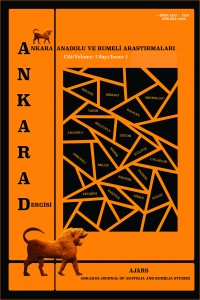Abstract
Ankara, bir çok medeniyete beşiklik etmiş Anadolu’nun kadîm yerleşim yerlerinden biridir. Tarihî süreç boyunca bu vasfa sahip olmasının en büyük sebebi, bu bölgede medeniyet kuran devletlerin ve toplumların Ankara’ya kattığı önemli kazanımlardır. Bu minvalde vakıf kurumunun önemli bir rolü vardır. Bugün bu kurumun özellikle Osmanlı döneminde toplumların sosyoekonomik, dinî ve kültürel yapısını büyük oranda etkilediği, şehir medeniyetine maddi ve manevi değerler kazandırdığı kabul edilen bir gerçektir. Bu değerler silsilesinden Ankara şehri de nasibini almış, vakıflar yoluyla şehir önemli ölçüde âbâd edilmiş, şehir halkının ihtiyaçları giderilmiştir. Bu bağlamda vakıf kurucularının tarihî süreç boyunca Ankara’nın gelişiminde büyük bir katkısı vardır. Bu kurucular arasında erkeklerin yanı sıra çok sayıda kadının varlığı da dikkat çekicidir. Bu makalede 1571 tarihli Ankara Evkâf Defteri’ne göre hayırsever kadınların Ankara’daki mevcut potansiyelleri ve etkinlikleri ele alınmıştır. Defterin tahlili, bazı vakıf sahibi hanımların vakıflarının Anadolu Selçuklu döneminden ve hatta Ankara’nın Osmanlı Devleti’ne dahil olduğu ilk yıllardan itibaren 16. yüzyılın ikinci yarısına kadar devam ettiğini, gelirlerin daha çok mescidlerin ihtiyaçlarını temin etmek üzere vakıflara aktarıldığını göstermektedir. Vakıf-mekân ilişkisine bakıldığında ise, vakıf kurucu hanımların hayır yaptıkları müesseselerin şehrin daha çok yukarı yüz olarak adlandırılan kale çevresinde, yani bugünkü Hacı Bayram Cami ve Karacabey Cami’nin çevresinde ve yukarısında yer aldıkları görülmektedir. Bu durum çok sayıda hayırsever hanımın kurduğu vakıfların eskiden beri var olduklarını, 14 15. yüzyıldan beri şehrin imar ve abâd edilmesine ve böylece bir çok eski müessesenin ayakta kalmasına büyük katkı sağladıklarını göstermektedir.
Keywords
References
- ONGAN, Halit, “Ankara Şer’iye Mahkemesi Sicillerinde Kayıtlı Vakfiyeler”, Vakıflar Dergisi, Sayı 5 (1962), s.213-221.
- ÖZCAN, Tahsin, Osmanlı Para Vakıfları, Kanûnî Dönemi Üsküdar Örneği, TTK yay., Ankara 2003.
- ÖZDEMİR, Rifat, XIX. Yüzyılın İlk Yarısında Ankara, Kültür Bakanlığı yay., Ankara 1998.
HOW ANKARA’S PHILANTHROPIST WOMEN CAN BE CONSIDERED IN THE CONTEXT OF THE RELATIONSHIP OF FOUNDATION AND PLACE?
Abstract
Ankara is one of the ancient settlements of Anatolia, which has been the cradle of many civilizations. The biggest reason for it to have this qualification throughout the history has been the significant contributions made to Ankara by the states and societies that have established civilizations in this region. In this regard, the foundation institution has played an important role. Today it is an accepted fact that this institution has greatly affected the socioeconomic, religious, and cultural structure of the societies and provided material and immaterial values to the city civilization, especially during the Ottoman period. From these series of values, the city of Ankara, too, has received its share, and, through foundations, the city has been significantly made prosperous and the needs of the people of the city have been satisfied. In this context, the founders of foundation have made great contribution in the development of Ankara throughout the history. Besides men, the existence of many women is remarkable, among these founders. In this article, the potential and activities of the philanthropist women in Ankara are discussed, according to the Ankara Foundation Registry dated 1571. The analysis of the registry shows that the foundations of some foundation-owner women continued from the Anatolian Seljuk period, even from the first years when Ankara joined the Ottoman State, until the second half of the 16th century, and that the income was transferred to the foundations mostly to satisfy the needs of the masjids. And when the relationship of foundation and place is considered, it is seen that the institutions that the foundation-founding ladies gave charity to are mostly located around the castle, which is called the upper side of the city, that is, around and above today’s Hacı Bayram Mosque and Karacabey Mosque. This shows that the foundations established by many philanthropist women have existed for a long period of time, and that since the 14th - 15th centuries they have contributed a lot to the development and prosperity of the city and thus to the survival of many ancient institutions.
Keywords
References
- ONGAN, Halit, “Ankara Şer’iye Mahkemesi Sicillerinde Kayıtlı Vakfiyeler”, Vakıflar Dergisi, Sayı 5 (1962), s.213-221.
- ÖZCAN, Tahsin, Osmanlı Para Vakıfları, Kanûnî Dönemi Üsküdar Örneği, TTK yay., Ankara 2003.
- ÖZDEMİR, Rifat, XIX. Yüzyılın İlk Yarısında Ankara, Kültür Bakanlığı yay., Ankara 1998.
Details
| Primary Language | Turkish |
|---|---|
| Journal Section | RESEARCH ARTICLES |
| Authors | |
| Publication Date | July 22, 2020 |
| Submission Date | June 8, 2020 |
| Published in Issue | Year 2020 Volume: 1 Issue: 1 |



